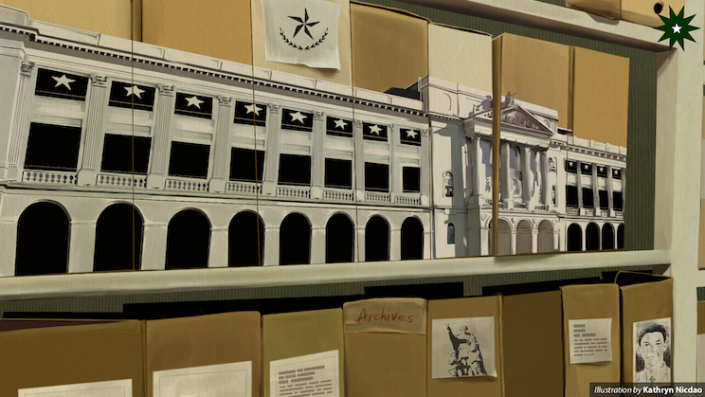Since their arrival on Philippine soil in 1911, the De La Salle Brothers have made their presence felt for over a century, establishing some of the nation’s top educational institutions and aiding Filipinos through their noble mission. Despite the growth that Lasallian education has had within the nation, De La Salle Philippines (DLSP) continues to stay true to its roots and work toward its goal of promoting zeal for service over a century later.
Standing as one of the biggest proprietors of education in the country, the telling of the Lasallian mission’s story would not be possible without the efforts of people like Ian Saulog and JR Alejandro, archivists at the De La Salle Brothers Archives, Lyn Mapa, Director of Museo De La Salle Bacolod, and Br. Francisco de la Rosa VI FSC, president of De La Salle University-Dasmariñas (DLSU-D). They share with The LaSallian how their offices preserve and conserve pieces of De La Salle Philippines’ rich history.

Keeping the Lasallian legacy
Being tasked as the archivists of the De La Salle Brothers Archives is no small job; it entails being the vanguards of the mission’s story in the country. Saulog shares, “[We archive] basically, everything that [the] Lasallian family produces. It may be in the form of documents, letters, photos, ephemera, giveaways, anything the Brothers [produce].”
“Lahat ng na-produce ng Brothers, we should have it or ideally. We should store it and keep it as archival heritage,” he states. While much of their collections consist of late Brothers’ “archival documents or things,” the historian discloses that the “Lasallian family” documented in their work entails also includes “teachers, students, schools, and their works.”
Similarly, several of the 16 DLSP schools have made efforts to preserve their communities’ stories as well. The archives of Museo De La Salle Bacolod primarily contain documents “relevant to the University of St. La Salle (USLS)”, the second school established by the De La Salle Brothers in 1952. While the museum’s archives were only formalized roughly a decade ago, their group has received contributions from “alumni, former teachers and staff, the Brothers, and offices”.
At DLSU-D, a section named the Archives and Special Collection (ASC) can be found within the college’s library. There, “the academic community deposit, vital documents, and special collections—such as memorabilia” are featured, Br. de la Rosa shares. Among the memorabilia there are trophies, pictures, and gifts that Brother Presidents garnered from the different places that their mission had taken them.
Stewards of history
The procurement system of the De La Salle Brothers Archives revolves around “four A’s”: assessment, acquisition, accession, and availability. When met with a potential addition, the La Salle Greenhills-based office first assesses whether or not a piece is “covered by their archives.” If they deem it, they proceed to the next step—acquisition—where they do the appropriate paperwork to “acquire [the piece] legally.” Once they are in possession of a piece, they subsequently move on to “accession” where they tag and sort pieces with appropriate serial numbers and work to make these “jewels”—as Saulog refers to them—available to the public.
Tasked with the seemingly synonymous duties of preserving and conserving the materials in their library, Saulog elaborates on their differences, “We preserve [so that] damage [will] be prevented…On the other hand, conservation treats the damages already present…We repair tears, we mend holes, insect bites, etc.”
While much technical knowledge is needed to preserve and conserve historical materials adequately, these skills are paramount to cementing and growing the legacy of the Lasallian mission. “The knowledge of proper organizing and handling of these significant archival documents and memorabilia will serve as valuable proof that the Lasallian core values of faith, zeal, and communion are manifested in the lives of [the] community,” Br. de la Rosa quotes.
Stories to tell
While all materials in the archive are “of importance,” Saulog shares that he felt a personal affinity to documents showing the charitable works of the Brothers, “When I see documents of Brothers and their personal missions in life; like [a] Brother, [for example,] meron pala siyang project with public schools. [I am able to see that] their work reaches beyond [their] schools, so natutuwa ako doon, personally.”
Mapa speaks from her inside perspective on La Salle’s story in the Philippines, “There are so many stories and documents that tell us of this journey from 1911 to the present. From the prestigious De La Salle University to the smallest La Salle school in the country, all have wonderful stories that are worth keeping in the archives and worth sharing with the community.” Br. de la Rosa details, “By following the ideals of St. John Baptist de La Salle, the La Salle schools work to provide high-quality education to students from all socioeconomic levels of society.” He also emphasizes the importance of documentation in showing the challenges and triumphs that the Lasallian community faced, “This will also define our place in society and our nation.”
Far from finished
In his ending message, Alejandro emphasizes the importance of accurate historical records in the day and age where historical distortion runs rampant, “The world has changed; archives were transformed into a source of information and reality about the issues that we currently face in this modern world.” Saulog adds, “In this age of information, it is ironic that disinformation is so prevalent.” He further emphasizes the importance of documents to back up claims, “Where do you go when you need information? Kailangan ng resibo. Ano yung resibo? Yung dokumento. Sa history may tinatawag na ‘no document, no history’.”
(You need a receipt. What is the receipt? The document. In history, we have a saying that goes: “no document, no history”.)
The former asserts that, “as stewards” of Lasallian history in the Philippines, they “ensure to be [a] reliable source of information and in order to keep and uphold our history and legacy; as well as to avoid disinformation and fabricated news.” Alejandro imparts his final quip with a laugh, “History is not tsismis.”
